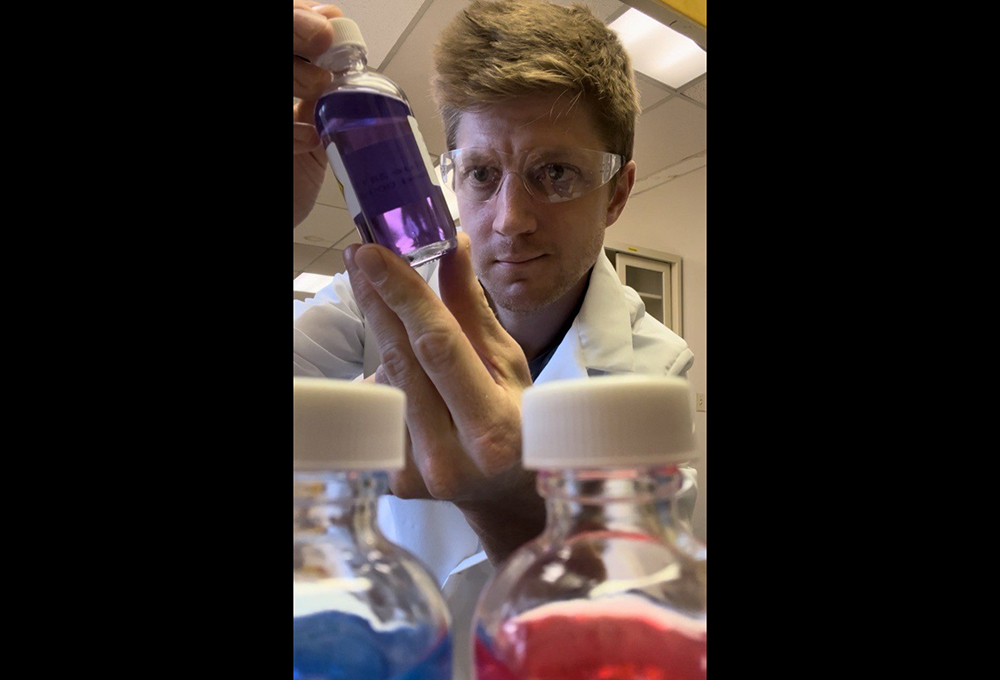
 Tom Corrigan表示,Prestone 的电动车技术研发团队正在研究下一代低导电性电动汽车热管理液体。(Prestone)
Tom Corrigan表示,Prestone 的电动车技术研发团队正在研究下一代低导电性电动汽车热管理液体。(Prestone) 电动车冷却液供应商一直在测试其产品的电导率水平,以符合中国新国标的规定。(Prestone)
电动车冷却液供应商一直在测试其产品的电导率水平,以符合中国新国标的规定。(Prestone) SAE电池标准委员会主席Brian Engle认为,电动车冷却液配方的重大变化旨在提高电动汽车电池的安全性。(Brian Engle)
SAE电池标准委员会主席Brian Engle认为,电动车冷却液配方的重大变化旨在提高电动汽车电池的安全性。(Brian Engle)
Prestone电动车技术总监Tom Corrigan博士指出,“直到近期,电动车冷却液才开始受到重视。”他牵头的科学家和工程师团队负责研发面向OEM和终端客户的下一代冷却液。Corrigan指出,下一代冷却液不仅需要能够实现高效热传递,还要与其接触的每个组件和材料(如聚合物密封件)兼容,同时具备与传统内燃机防冻剂相同的防腐蚀性能。最重要的是,它必须能有效遏制热失控等极端故障蔓延至整个电池组。
不仅如此,监管压力也正在逼近。中国政府已经起草了一项针对电动车冷却液的法规(GB 29743.2),旨在降低冷却液电导率以减少电池火灾。SAE电池标准指导委员会主席Brian Engle表示,预计该法规将于2026年7月生效,届时所有在华销售车辆都必须符合该法规要求。
Engle解释道,“该法规规定,新型冷却液电导率不得高于100μS/cm,即使考虑老化效应,其电导率也不得高于300μS/cm。这就要求未来电动车冷却液设定明确的使用寿命,而非无限期使用。这一要求将改变冷却液的配方。”
请关注有关中国 GB 法规和 SAE 正在进行的电动汽车热管理液标准工作的单独报告。
Managing the heating and cooling of electric vehicle propulsion systems may seem to be an easy task compared with combustion engines. After all, ICEs run much hotter—the thermal optimum for a gasoline engine is around 100-degC. By comparison, EV batteries normally generate (as a function of current during charge/discharge cycles) a relatively cool 15- to 30-degC. And while motors and power electronics operate hotter, typically 60- to 80-degC, they still run cooler than ICEs.
But among the myriad complexities of EV thermal management are batteries’ dislike for temperature extremes, new cell chemistries, heat-generating high-voltage electrical architectures and 800V fast charging. All are putting greater focus on maintaining stable EV battery thermal performance and safety. Experts note that compatibility among the cell chemistry, hardware, and coolant fluid is the key to a balanced systems solution.
“EV liquid coolant has kind of been an afterthought until recently,” noted Tom Corrigan, Ph.D, director of EV Technology at Prestone Products Corp. His team of scientists and engineers is responsible for developing next-generation thermal-management fluids for OEM and, eventually, consumer customers. Corrigan said that beyond their vital role in enabling efficient heat transfer, fluid formulations must be compatible with every component and material they contact, such as polymeric seals. They also must provide internal corrosion protection (as does traditional ICE antifreeze). And perhaps fluids’ most vital role: Helping to prevent an extreme failure mode, i.e., thermal runaway, from spreading throughout the battery pack.
“Low electrical conductivity is a must for thermal-management fluids which could potentially come into direct contact with high voltage electronics,” Corrigan asserted.
Low-conductivity coolants taking over
The ‘first wave’ of EV adoption established the electric-vehicle market before coolant suppliers had time to develop bespoke thermal-management products, Corrigan explained. “Most EVs on the road today are using the same fluids that are used in ICE vehicles, he said. “We’re [Prestone] long established with many OEM customers, so when those OEMs started producing EVs, they installed the coolant fluids they trust for corrosion protection.”
Corrigan sees a shift in the industry’s thinking, mainly driven by EV safety concerns. For motor cooling, two main strategies are being used today: Indirect and direct cooling. Indirect cooling uses the same water-glycol-based fluid, with corrosion inhibitors, that is used for the battery pack. The motor housing serves as a coolant jacket, allowing the fluid to flow through it and extract heat indirectly from the motor system.
“The issue with the current additive packages and their proprietary blend of corrosion inhibitors, is that the industry had, for a long time, moved towards ionic corrosion inhibitors for ICEs,” Corrigan explained. Ionic additives include silicate, organic acid, and phosphate technologies, all of which increase electrical conductivity.
“With high electrical conductivity, if that fluid were to come in contact with the high-voltage electronics, 400V or 800V systems, you’ll have a pretty violent, catastrophic reaction,” he said, citing studies that show that submerging a lithium-ion battery in traditional ICE coolant results in high heat generation. “There’s a good chance that [heat generation] will cause the coolant to boil with potential for fire and thermal runaway.”
Such risks, combined with increased thermal performance, have spurred over 50 percent of EV manufacturers to adopt direct cooling strategies for the motor, according to Corrigan. This method uses an oil-based ‘dielectric’ fluid, with very low or zero conductivity, depending on the formula. The fluid flows directly over the motor coils. Dielectric fluids are also entering battery thermal management; with direct (also known as immersion) cooling, the battery cells are submerged in the dielectric coolant.
“By moving to the low-conductivity coolants we’re developing, you can mitigate those issues. The opportunity for my team, the formulators, is to find synergies that maintain low electrical conductivity while ensuring sufficient corrosion protection for the OEMs,” Corrigan said. “The anti-corrosion function aims to eliminate a build-up of materials or intermission of heat transfer or, worse-case scenario, a build-up of materials to the point it causes a fluid leak into areas of the battery where it’s not supposed to be.”
The Prestone R&D team’s developments include new performance additives formulated to enhance the thermal properties of the fluids themselves to provide a more efficient heat exchange between two components. Corrigan claims that will benefit any type of cell chemistry and may help “level the playing field” for NMC versus LFP in terms of cell chemistry safety, he said. OEMs are expected to transition to the new EV thermal fluids “over the next couple years,” according to Corrigan
New China regulation
Is EV fluid maintenance by the vehicle owner—fluid changes—coming? The standard coolants used in most EVs today are “life of vehicle” and do not require a fluid change. “But as we move to low-conductivity fluids, we’re seeing a ‘creep’ in conductivity over time,” Corrigan observed. As the coolant degrades and picks up impurities in the system, it forms ionic species. Conductivity increases, and by the time it reaches 300 μS/cm [microsiemens per centimeter, a unit used to measure electrical conductance], safety concerns start to emerge. That’s where we would recommend a fluid change.”
A regulatory push is also looming. The Chinese government has drafted an EV-coolant-specific rule, GB 29743.2, focused on reducing electrical conductivity to mitigate battery fires. The regulation is expected to go into effect July 2026, and all vehicles sold in China must comply, according to Brian Engle, chair of SAE’s Battery Standards Steering Committee and director of business development at Amphenol, a connectivity provider.
“They’re basically setting a maximum limit of 100 microsiemens per centimeter dielectric measurement for new coolants with basically an aging effect allowing for up to 300 microsiemens/centimeter [300 μS/cm],” Engle explained. “Moving forward, it’s going to require a service life for EV coolants, as opposed to being in the vehicle indefinitely. It’s going to change the makeup of the coolants.”
Prestone’s Corrigan said the China GB threshold of 100 μS/cm “is a pretty safe value if there was an accident involving accidental contact of that fluid with the high-voltage electronics. But that’s where the challenge comes in. The conductivity comes from the additives we put in to protect against corrosion. If we pull those out, we can reduce conductivity but now we compromise on corrosion. Our R&D team has done a lot of development work on technologies that allow us to pass the corrosion requirements in that [China] GB specification while maintaining low conductivity. Our fluids are around 75 μS/cm.”
Watch for a separate report coming on the China GB regulation and SAE’s ongoing Standards work on EV thermal management fluids.
等级
打分
- 2分
- 4分
- 6分
- 8分
- 10分
平均分
- 作者:Lindsay Brooke
- 行业:汽车
- 主题:材料零部件质量、可靠性与耐久性
